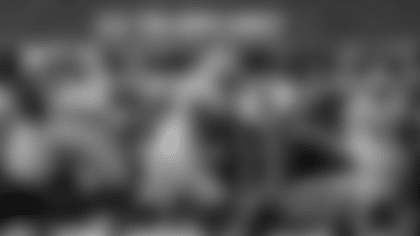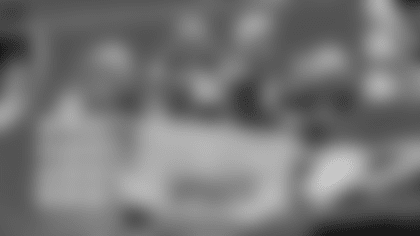GREEN BAY – The angles of analysis applied to the Packers' 2020 draft include both what they added and what they didn't, as well as future projections versus immediate help.
Here's an attempt to break it all down, with the post-draft comments from General Manager Brian Gutekunst and Head Coach Matt LaFleur:
The potential heir apparent at QB
This draft will be known in the history books as when the Packers traded up for Utah St. quarterback Jordan Love in the first round.
Presumably Aaron Rodgers will pass the torch to him at some point, but Gutekunst stressed there's nothing automatic about the eventual transition. Rodgers got the reins in 2008 because he had proven he was ready to succeed in the NFL, not due to some artificial clock.
"That's got to happen with Jordan," Gutekunst said. "You've got to work, you've got to earn it, you've got to become a good enough player.
"We have one of the best to ever lace them up, and we're shooting for championships for as long as he's here, and we expect him to be here for quite a while. Jordan's got to learn, he's got a lot to go."
LaFleur feels a good starting point for Love is his humility, and the accountability he took for his mistakes when reviewing film of less-than-favorite plays.
"I think that gives you a chance any time you have that kind of mindset," LaFleur said. "The talent is there. He is a natural thrower. He's fearless in the pocket, he's athletic."
LaFleur added he believes Rodgers will be a strong mentor, and neither the coach nor the GM, who both spoke with Rodgers over the weekend, expressed any concerns about the dynamic between the two quarterbacks.
For all the excitement about Love's potential and future at the controls, no one is pushing Rodgers out the door.
"Aaron is a pro, and he's the leader of our football team, and I anticipate that for a really long time," LaFleur said.
"Aaron's by far the best quarterback I've ever been around. I think he's the best ever to play the game. I hope he can play until he decides he doesn't want to play anymore."
No new receivers
After all the talk about this being the deepest wide receiver draft class in several years, the Packers didn't select a single one amongst their nine picks.
Turns out, Gutekunst didn't share the opinion of the group's depth, explaining he was impressed with a lot of the receivers at the top of the draft, but not so much beyond that.
Reading between the lines, it appears the receivers the Packers liked most were gone in the first round before Gutekunst was in position to trade up, which turned the focus to Love. And the early run on receivers in the second round took the next set of options away, too.
From there, he simply didn't see receivers who were going to unseat young players like Allen Lazard, Marquez Valdes-Scantling, Jake Kumerow, and a returning Equanimeous St. Brown, all of whom he's betting are still on the rise.
"It wasn't like we weren't looking to add to that competition, we just felt that there wasn't a lot of great candidates that were locks to make our team next year," Gutekunst said, adding how difficult it can be for rookies at that position to make an impact, even when they're the cream of the college crop.
He also referred to the receivers' third year as their "sweet spot where those guys really take off."
LaFleur mentioned being excited to work with free-agent acquisition Devin Funchess, a proven veteran, but also wanting to get Kumerow more involved, give St. Brown a restart following his season-long injury, and push Valdes-Scantling to really hit his stride.
"The speed he has, he has to take that next step," LaFleur said of MVS. "That's going to be a challenge for him, and we're going to be all over him to do that."
Other offensive pieces
Boston College running back AJ Dillon is an intriguing addition to the 1-2 punch of Aaron Jones and Jamaal Williams in the backfield, but again, nothing will be given to him.
"A.J. Dillon's gotta come in and he's gotta prove it and he's gotta compete with the other guys that we have on the roster," LaFleur said.
But it's clear LaFleur is fired up about adding a 247-pound back with 4.5 speed. He also practically couldn't contain his excitement about Cincinnati tight end Josiah Deguara, whom he views as a "gritty, tough player" who can line up anywhere in the offensive formation, to keep defenses adjusting and reacting.
As for the three offensive linemen drafted in the sixth round, their opportunities for rookie impact aren't likely to be as plentiful (barring injuries) as those of Dillon and Deguara.
But the combination of smarts, strength and character of Michigan's Jon Runyan, Oregon's Jake Hanson and Indiana's Simon Stepaniak makes them good culture fits. Gutekunst added he believes Stepaniak would have been drafted much higher if not for a late-career knee injury that has created an uncertain readiness timeline, but his ability was worth taking a chance on.
The run defense
Similar to receiver, the Packers didn't change much in this draft with regard to their run defense, which ended last season on an awfully sour note in the NFC title game.
Minnesota inside linebacker Kamal Martin will have a chance to earn a role alongside free-agent pickup Christian Kirksey if he can return to his 2018 form prior to his 2019 knee injury. But a fifth-round rookie isn't likely to dramatically alter the look of the run defense.
Neither are the two seventh-round defenders, TCU safety Vernon Scott and Miami edge rusher Jonathan Garvin, simply due to their positions. Scott is a speedy late bloomer while Garvin has similarly unknown upside, but their promise doesn't address the defense's biggest glaring weakness.
Rather, LaFleur suggested in addition to seeing more progress from young defensive linemen (Kingsley Keke, a sixth-round pick a year ago, being the youngest), the run defense's issues can be shored up schematically by changing some approaches up front.
"We've had a lot of conversations about what can we do differently," LaFleur said. "Everybody looked inward."
***
That's ultimately what it will take across the board for the Packers to improve in 2020 – progress from within. Last year, free agency and the draft produced six new starters, and free agency might have found three more this year.
But that kind of lineup turnover can't be a repeating occurrence in order to sustain success. At some point, it becomes more about players with room to grow fulfilling their promise.
This draft shows the Packers placed a big bet on that.















